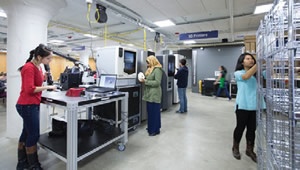Academic Makerspaces Foster Innovation

Sears think[box] at Case Western Reserve University is one of the largest university-based innovation centers in the world, hosting 5,000 monthly visitors.
Before Case Western Reserve University established their innovation center Sears think[box], access to 3D printing was limited to a small section of engineering students. With just two 3D printers in a design studio used only for specific engineering courses, no one else had access.
In order to get more accessible cutting-edge technology, promote innovation and hands-on learning, Case Western created an on-campus, open environment where applied learning, design and product development intersected. Now one of the largest university-based innovation centers in the world, the Sears think[box] operates as an innovative and entrepreneurial makerspace for students and the surrounding community. It’s a home to educators, mentors and facilitators who help students and faculty become future leaders and innovators by nurturing, developing, funding and commercializing ideas across disciplines.
“Most companies want technical skills and multidisciplinary team experience,” says Malcolm Cooke, Sears think[box] executive director. “Through Sears think[box], we’re able to promote the use of creativity, innovation and entrepreneurship across campus. This, in turn, supports a wide range of interdisciplinary exploration and activity.”
Makerspaces like think[box] give students access to advancing 3D printing technologies. Today, the innovation center hosts more than 5,000 monthly visitors, many of whom use Sears think[box]’s 3D printers to bring their ideas to life. Chosen for their robust capabilities and user-friendly software platform, Stratasys technologies like FDM and the F123 Series put the power of ingenuity and design iteration into the Sears think[box] user’s hands.
Because of its success and leadership, Case Western and the Sears think[box] will be hosting the 2017 International Symposium on Academic Makerspaces (ISAM), September 24-27. ISAM brings together higher education makerspaces to maximize their impact on student learning experiences and alumni success, and simply get students and faculty excited about making.
www.stratasys.com
This article originally appeared in the issue of .